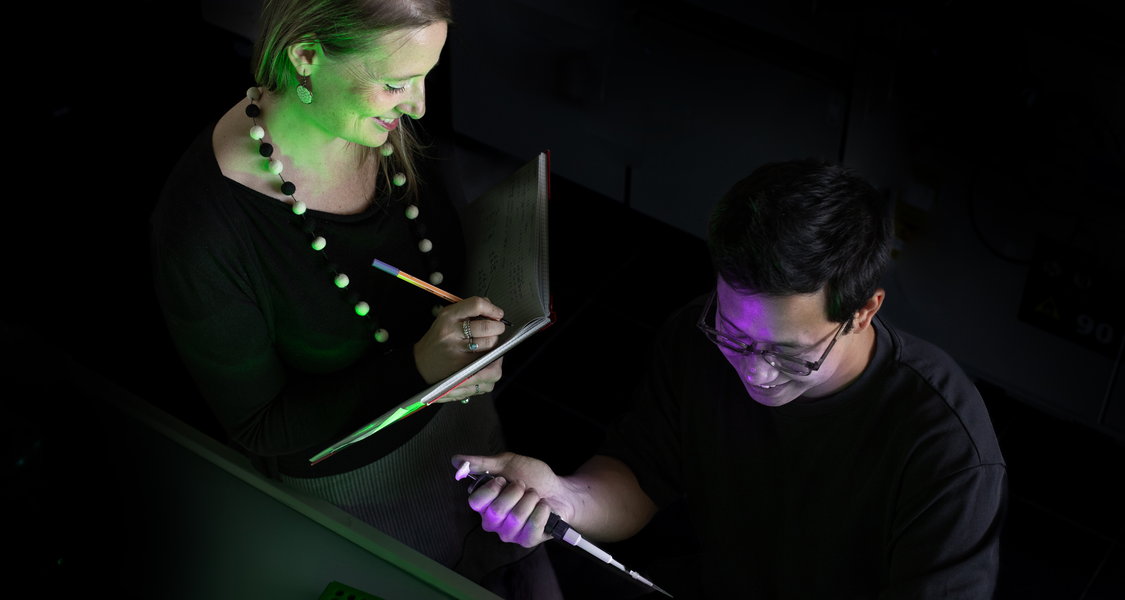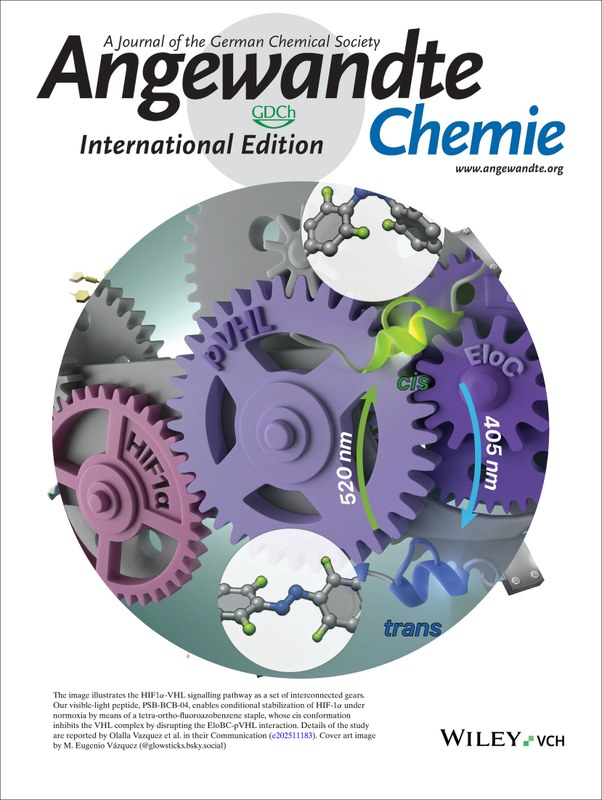31.08.2025 Switching Cellular Oxygen Responses with Light
Researchers develop a molecular light switch that allows on-demand stabilization of the transcription factor HIF1α.

A team at Marburg University has first developed an optochemical tool that can influence the body’s central oxygen-sensing protein, HIF1α — the discovery of its main role in how cells sense and adapt to oxygen availability was awarded with the 2019 Nobel Prize in Medicine — and thereby turn on associated genes at will. The study led by Dr. Van Tuan Trinh, a recent graduate from the Chemical Biology lab of Prof. Dr. Olalla Vázquez, describes a visible-light activated stapled peptide that provides spatiotemporal control over HIF1α, i.e. the master regulator of gene expression under low-oxygen conditions. This breakthrough, published as a Hot Paper and features on the cover of the leading chemistry journal Angewandte Chemie demonstrate how typical low-oxygen responses can be conditionally triggered by the combination of this peptide and light.
Prof. Olalla Vázquez is delighted by the recognition. “Seeing our work featured so prominently shows that the scientific community values this advance in optochemical control.” The Hot Paper designation particularly reflects the novelty of using a visible-light photoswitch to manipulate cellular oxygen responses and, in particular, a protein like HIF1α, which could inspire many applications. The cover art, created by Prof. M. Eugenio Vázquez, encapsulates the concept: a light-triggered gear halting the degradation of HIF1α, thus keeping the gene-regulation engine running. This striking image and the research behind it together convey a clear message – with the right molecular switch, scientists can control life’s intricate circuits with extraordinary finesse.

Switching the protein machinery on and off by light
The Vázquez team’s photoswitchable peptide – named PSB-BCB-04 – works as a molecular light switch. In essence, they “stapled” a small peptide with a light-sensitive chemical linkers that can flip its shape when exposed to specific wavelengths of visible light. Green-light irradiation induces the peptide conformation capable of tightly binding to the protein complex responsible for HIF1α degradation; i.e. the peptide blocks the EloBC–pVHL interaction. By interfering with this protein-protein interaction (EloBC–pVHL) the peptide effectively tricks cells into activating hypoxia-response genes under non-hypoxic conditions. As a result, HIF1α is stabilized in the cell even under normal oxygen conditions. When blue light shines, the peptide’s conformation changes and, in turn, HIF1α levels as well as the activity of HIF-controlled genes such as the vascular endothelial growth factor (VEGFA) – a gene involved in blood vessel formation. Having this precision by only using light without permanent genetic changes provide is invaluable for both research and therapeutic strategies in the field of Photopharmacology.
Bright prospects: from regenerative medicine to targeted cancer
This methodology opens new avenues by enabling precise control of hypoxia-inducible factors (HIFs), central players in disease and healing. “HIF1α regulates over a hundred genes involved in oxygen transport, blood vessel growth, metabolism, and immune function,” explains Prof. Olalla Vázquez. “Its precise control is medically relevant in conditions ranging from cancer and ischemia to anemia and wound healing.” Tumors exploit HIF1α to survive low oxygen and grow blood vessels, while activating it can aid tissue and nerve repair. The Marburg team’s light-gated peptide offers spatiotemporal precision—activating HIF1α only where and when needed—potentially maximizing benefits while reducing side effects. Beyond HIF1α, the approach showcases a general strategy: using light-responsive peptides to regulate protein stability and interactions on demand. Adapted to other systems, this could enhance targeted protein degradation, complementing existing tools like proteolysis targeting chimeras (PROTACs) with conditional, light-controlled precision.
More information https://olallalab.org/
Publication: https://doi.org/10.1002/anie.202517898
Contact
Prof. Dr. Olalla Vázquez
Tel.: +4964212822745
Mail: olalla.vazquez@staff.uni-marburg.de
Chemische Biologie
Fachbereich Chemie
Philipps-Universität Marburg/Marburg University